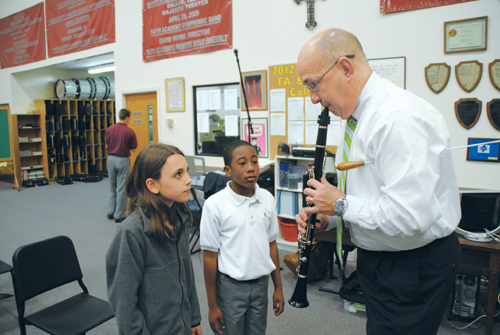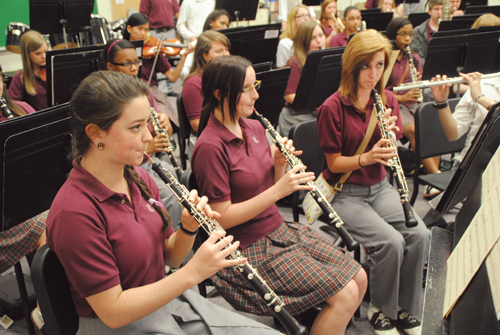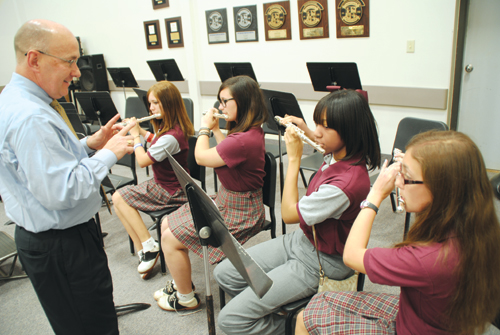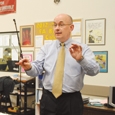
Faith Academy in Mobile, Alabama has only had a band since 1997. David Pryor was hired to start the program and has been at the school for the last 16 years. Pryor explains, “The school was started in the late 1960s, but for almost 30 years did not have a band. At my interview I asked why they wanted a band. The headmaster responded that the school was losing students, and they wanted to give them the ability to use their talents. I knew then that I wanted to work there. The wrong answer would have been if the administration had wanted the fight song played at football games.” The school’s Symphonic Band has performed all across the United States, including Carnegie Hall and Chicago’s Symphony Center.
What are the perks of running the entire program yourself?
One of the beautiful things is that I can control the instrumentation. I have the numbers to be able to select the instrumentation in the top group. The instrumentation of the younger bands may not be as good, but down the road I will switch some flute players to oboe or bassoon and trumpet players to euphonium or horn.
I demonstrate instruments at the end of the school year for fourth graders. I start beginners on flute, clarinet, alto saxophone, trumpet, trombone, percussion, and, if there is a student physically large enough, tuba. I send information to parents, including a form they must sign. It indicates that the child will test for an appropriate instrument. I am always concerned when directors let students play any instrument they want without checking to see whether they will succeed on it. I had a student who transferred in as a clarinetist and walked in with a blue clarinet. I try to be cautious because I am at a private school where parents pay a lot of money for tuition, but I was not going to have that blue clarinet in my bandroom. It was never going to produce a good sound, so I quickly said to her parents, “I think she is overblowing this clarinet, but I see some potential. Do you mind if we look at bass clarinet? The mechanics are still the same, but she needs a bigger clarinet.” The student felt I was selecting her for something special, and I got the blue clarinet out of my band room.
I start thinking about switching students in seventh grade. This means finding someone with the right personality for the new instrument. I have approached some students who adamantly refuse to switch. Those who do not immediately refuse I ask to think about it, and sometimes it opens up a whole new world for them. You can see they are having more fun playing the new instrument than they ever were the old one. This happened this year with a ninth grade trumpeter who started band late and is not in the Symphonic Band. I approached him in March and said, “Your trumpet playing is going well, but I see the possibility of you being a horn player. Things in your embouchure make me think you could do well as a hornist, and I think it could propel you into Symphonic Band next year.” He asked what his chances were of making the Symphonic Band on trumpet, and I told him truthfully he wasn’t quite there yet. He decided to try horn.
Within a few minutes he started getting the partials down. By April he was already a better hornist than he was ever going to be a trumpet player. He asked if he could still play trumpet in jazz band, so I put him on the low trumpet parts to avoid hindering his work on horn. The same thing happened with me. I was originally a trumpet player who switched, and after making the move did not touch a trumpet again until a college methods class. I started to enjoy playing it and bought an old trumpet just to have available to play again. My daughter is following the same path from trumpet to horn.
Some students take longer to realize that switching was a good choice. I had a young man who graduated valedictorian of the school and is now a music education major at the University of Mobile. He came to me in middle school as a trumpet player. He had a nasal sound that was never really open. He could understand any of the music, but struggled physically to get to F5. At the end of his eighth grade year, I said to him, “You are a tuba player. How did you ever end up on trumpet?” He switched but told me several times during his freshmen year that he was not enjoying the tuba. I asked him to give it time and he eventually passed another student who had played tuba since fifth grade. He made all-state his senior year and loved the tuba in the end.

How do you teach beginners?
While in St. Louis. I learned a great lesson from Bob Schmiehausen, the band director at Chaminade Academy. He told me, “Find a good method book, and when you work an exercise, do not go to the next one until the first is perfect. When you start doing that, every time you begin something new, your students know that they are going to work on it until they can play it perfectly.”
Sometimes daily, sometimes every other day, I pick an exercise for the beginners that has a new fundamental, such as a new note or dynamic marking, and often spend the entire period on it. I will announce that we will sightread the exercise in two-measure sections. It is essential to train students properly from the start. I teach beginners how to sightread using exercises in the method book. I ask who can play the first two measures and might have five students raise their hands. I have one play the first two measures and another play the next two; soon the entire exercise is played close to perfectly, but only by four students.
I then expand on that. If the student who played the first two measures is a flutist, I have all the flutes play the first two measures. The other two-bar chunks will be played by the sections of those soloists, so soon the whole band is playing some portion of the exercise. The next day, it is amazing how many students can play the entire exercise. They heard the measures played, and all they had to do was learn a few more measures at home. This approach makes it possible to move through a method book quickly. Students often learn from each other better than they will from me. I can show students how to play something, but it lights a fire under them if they hear another student do it. They want to be the one who gets called on to demonstrate in class. When students are called on consistently to demonstrate, they always want to play at that level.
Because my program is under one roof, younger students hear what the older ones are doing in the higher-level ensembles. For directors who teach at multiple schools, it takes some creativity to get older students working with younger ones. Once a semester, take the top high school students to the middle school to sit in and play with the band.

What are the most difficult parts of being on your own?
If my top band cannot play the music I want to conduct, I have no one to blame but myself. I get frustrated when I hear about band programs where the middle schools are struggling but the high school director complains instead of going to the middle school to help and get to know the younger students.
Running the entire band program yourself means making difficult decisions on what the program will do best. That means if you focus on having the concert band play exceptional music, you may not be able to have a jazz program or the marching band might not attend competitions.
How do you handle marching band?
Originally, the jazz band played at football games. They played the national anthem and fight song and jazz tunes and built up their chops and repertoire. We recently changed athletic conferences from one that was strictly private schools to one with public schools. In the old conference there was no pressure to form a marching band because some of the schools did not even have band programs. With the public school conference, we had to look at marching band and decide what would work for football games.
Rather than a marching band, we created an extracurricular drum and bugle corps consisting of the brass and percussion players from the symphonic band, and some woodwind players who learn brass instruments or percussion to join the group. I borrowed the idea from the University of Mobile, which has a similar ensemble. The percussion is set in a concert setting behind the brass. The brass do horn flashes and other such choreography, and they move around to let featured sections be in front. We usually have a drum feature.
A couple years ago I had an extremely talented percussionist capable of sightreading four-mallet pieces without missing much. I arranged Flight of the Bumblebee as a percussion feature for the ensemble. The brass played an opening fanfare and then moved off to the side as my percussionist took off his snare drum while a couple parents rolled in a xylophone. After the solo, the brass moved back into concert formation, and the show continued. The group does not actually go on the field but performs in front of the stands.
What are the obstacles to running a full marching band?
The primary reason we do not have a marching band is the cost. There are bands in the area that spend $80,000 on their halftime show. I don’t have that money and cannot put on a show that will look and sound as good as an $80,000 one. The expenses add up quickly when factoring in writing a show, guard equipment, and charting. I do think money some people spend on marching band might be better placed. To spend six figures on a halftime show but have concert band equipment fall into disrepair is no good.
Another reason we don’t have a marching band is that I teach more than 220 students by myself. I have to set priorities. Our school is K-12th grade with 2,000 students. I teach all levels of band from fifth grade up. That load includes all-state, solo and ensemble for all levels, two jazz bands, and a percussion ensemble. Few of my students even have the money to take private lessons; the responsibility to teach them falls on me.
When people ask why we don’t have a marching band, I tell them to look at what the program offers and the success we have had. Some students would love to try marching band, but others would quit because they just want to play their instruments. It is unusual, but it has helped our program. With the lack of funding and manpower, I have to figure out how to compete with the public schools. If it means that we don’t march but the rest of the program is competitive, then that’s what we will do. The high school group, according to state qualifications, should only be able to play grade 2 and 3 music, but actually plays grade 4 and 5 music. Last year they played Chance’s Incantation and Dance and Holsinger’s Liturgical Dances. This year they played Ticheli’s Vesuvius, Gillingham’s Century Variants, and Holsinger’s Quiet River.
• • •
Structuring the Program
Lower Bands
Placement is by ability and not grade level. There are four levels of band from fifth grade through high school. The beginner group has 40 students who are primarily fifth graders with a few sixth graders who were not in band the previous year. They work from the first method book all year.
The next level up is Concert Band 2. It is primarily sixth graders with a few seventh and eighth graders and the occasional ninth grader who plays at a second-year level. Concert Band 2 works through book two and goes into book three. If students finish book two and get into book three, they will move up to Concert Band 1. If they are still in book two because of poor practice habits or struggles, they spend another year in Concert Band 2. I don’t make them go back to the beginning of the book, but they continue where they left off. Some advanced students are promoted in the middle of the year.
Concert Band 1 is basically a strong middle school program with 60 students who are mostly seventh and eighth graders. It is rare for me to have anybody beyond ninth grade. I once had a senior who never made it into the Symphonic Band. He loved band, but just never made it into the top group. It made contest classification interesting as there is no category for ensembles with mostly middle school students plus one high school senior.
Symphonic Band
The Symphonic Band is entirely high school students, but not all of my high school students, as some are still in the lower groups. No one gets into the Symphonic Band just by grade level. In too many schools high school students are automatically in the top band, even if the playing ability is not there. This either frustrates a struggling student or brings the playing ability of the band down.
To get into the Symphonic Band, students have to play all twelve major scales from memory. Those who play flute, clarinet, or percussion have to play them in two octaves, which is consistent with all-state requirements. I have all students prepare the all-state etudes, as well. I do not require students to audition for all-state; I pick those who are ready and offer them the opportunity. I don’t want my students to waste the judges’ time, although I will permit students who are right on the edge to try. I want them to know what it is like to audition so they are more prepared next year.
Students do not have to participate in solo and ensemble contests, but to make sure everything is progressing, I devote a great deal of rehearsal time to practice on ensembles and solos. If I have ten flute players, but only four will play in the contest, I don’t want the other six twiddling their thumbs during rehearsals. To avoid this, I require every student to prepare a solo in the spring. For students who do not participate in the solo and ensemble contest, I set aside a day for them to perform for me.
If students meet the requirements – the major scales, exercises, and solos – then they are considered for Symphonic Band. Once students are in the top band, it is necessary to maintain their skills. It has been a while since I did this, but one year I moved six students down from Symphonic Band to Concert Band 1. It woke up everyone else and let them know they had to keep earning their spot. I want it to be an honor to get into the Symphonic Band.
Other Opportunities
I encourage students to get involved musically in their churches. Growing up, I had good friends who played horn and belonged to a big Baptist church in town. One Sunday I accompanied them to church and was asked to bring my horn because they played in the church orchestra. I joined this group and soon learned why they sightread so well. The music director handed out music each week for the next service, and they had to have it ready to go for the sake of the choir. This music director would also periodically say, “We don’t have any trombones this week, so horns, you have to read a trombone part.” I learned how to transpose by sight. The services were televised, which created additional pressure. Because I learned so much from this experience, I let local churches know when students in their congregations are musically ready to participate in services. The students who do this dramatically improve because they perform every Sunday.
• • •
 Covering Bassoon Parts
Covering Bassoon Parts
I only have one bassoonist in the Symphonic Band this year, so I occasionally give parts to my bari sax player to help out. I fooled all the judges at our state performance this year on a David Gillingham number that had two sections with meaty bassoon parts. I had given the bari player the bassoon parts and a silk scarf to put over his bell while playing them, a trick I learned from a local saxophonist who had done quite a bit of classical playing. A strong bari sax player can overtake even an entire tuba section, but laying a silk scarf over the bari bell will soften the sound enough that it can be difficult to tell what instrument is playing. It has to be silk, not cotton, and it works especially well when covering technical bassoon parts. After receiving the judges’ tapes I played them for the band and stopped at that section. Every judge commented on how good the bassoon sounded. My bassoonist beamed, but I told him he ought to thank his back-up player, who probably put out more volume than he did.
• • •
David Pryor has been teaching for 24 years, including the last 16 at Faith Academy. He has taught in Louisiana, Missouri, and Alabama. Pryor is a graduate of Loyola University in New Orleans and studied conducting under Lacey Powell, Joseph Hebert and Joe Barry Mullins. He was awarded the Citation of Honor in 2005 from the NBA. He was also named Faith Academy Teacher of the Year in 1998. Pryor is actively involved in St. Mary’s Catholic Parish and was head of religious education for the parish. He is also a member of the Mobile Singing Children staff, as well as numerous professional organizations. He and his wife Caroline have one daughter, Virginia, who attends Faith Academy.





